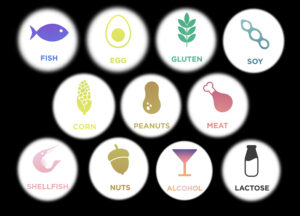
The prevalence of food allergies in the United States has risen at alarming rates in the past few decades. This epidemic has no currently known cause, however there is lots of speculation of possible origins as research continues to develop.Â
What is a Food Allergy?
Over the last few decades, the rate of food allergies in the United States has drastically increased. Children are far more likely to develop food allergies than ever before, though the reason for these developments remains unknown. The CDC has recorded that approximately 1 in 13 children has a food allergy, with no definite cause.
Allergies are the immune system’s negative response to substances that are typically harmless to other people. A reaction can occur in response to a variety of things, such as food, medicines, animals, or pollen. Responses to allergens differ depending on the person, but may include skin redness, hives, upset stomach, difficulty breathing, or even anaphylaxis. Ranging in severity, food allergies can be anywhere from mild to life-threatening.
Determining Food Allergies
There are many ways food allergies are investigated and diagnosed. Most commonly, an individual may ingest an allergen before they know they are allergic, and require medical attention because of their reaction. Confirming an allergy can be done through skin prick tests or blood work that determines if the immune system has produced antibodies to an allergen. If it has, it will recognize the allergen as a potential threat and have an allergic reaction as an immune response.
Additionally, if it is determined that the risk for an allergic reaction in an individual is low, they will be given a food challenge. In this situation, the patient is given increasing amounts of the suspected allergen in order to see if they are allergic. This of course may cause a reaction but is a safe method used to observe symptoms and their severity.
Possible Reasons for Increase in Individuals with Allergies
One of the most common theories for the cause of allergies is an absence of natural pathogens in the modern environment. This may cause the body to be hypersensitive to certain substances which in turn develop allergies. Additionally, it has been theorized that early introduction or delayed introduction of allergenic foods to infants may also cause food allergies.
Previous theories have been replaced by a new one that has been developed by immuno-biologists. They propose that the U.S. food quality control system is largely to blame for a high rate of food allergies. This quality control system is designed to protect us from eating harmful foods, but may be what is harming us in the long run. Unnatural methods heavily utilized in modern homes such as heavily processing foods as well as environmental chemicals in household soaps and detergents are irritants for many individuals.Â
Hopes for the Future
To conclude, Americans are developing food allergies at an alarmingly high rate – more than ever before. These allergies interfere with our day-to-day lives and can be life-threatening. At the moment, we are unsure of their cause or how to begin mitigating them. But with more knowledge than ever before and with continued research and findings, we can act accordingly to stunt the drastic rise in food allergies.Â



